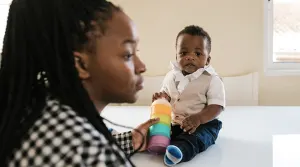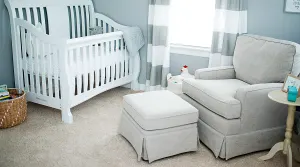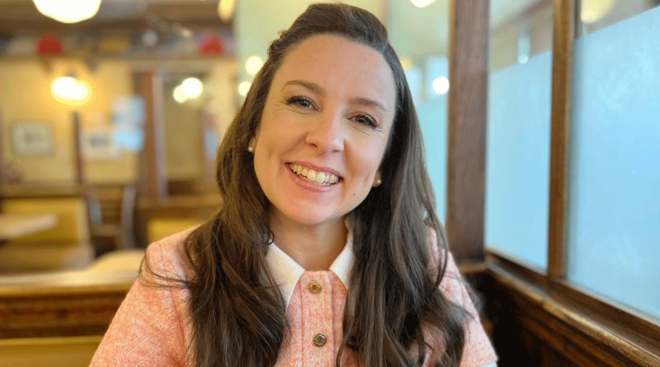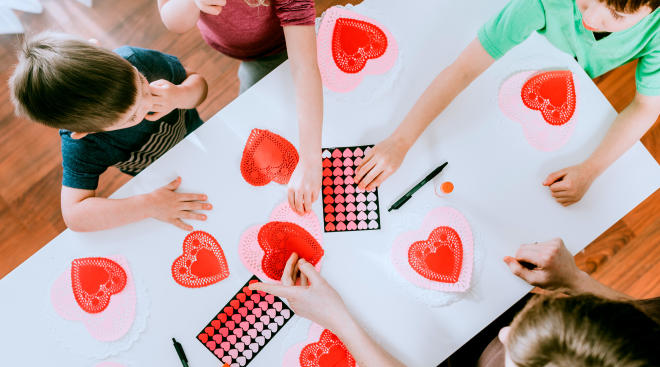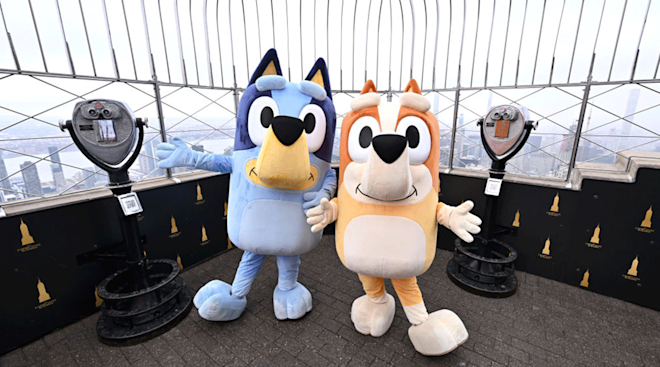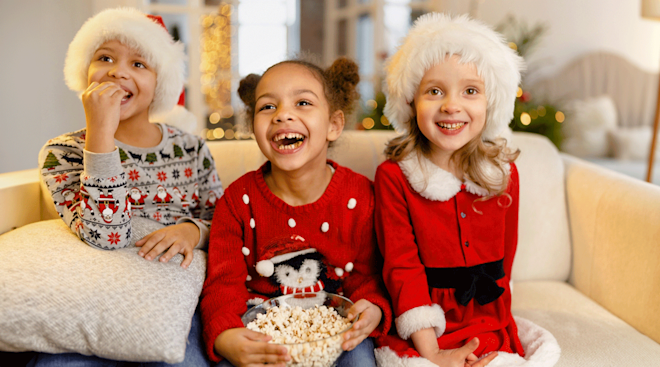What Are the Best Low-Stimulation Shows for Toddlers—and What Benefits Do They Offer?
Among TV shows that seek to capture children’s attention through fast pacing, super-bright colors and repetitive songs, it’s no wonder parents are longing for something calmer. In fact, 80 percent of parents are seeking out low-stimulation shows for toddlers and babies, according to a social media poll by The Bump. Non-stimulating kids’ shows—like Daniel Tiger’s Neighborhood—feature slower pacing and peaceful plots that are said to help with language development, support emotional growth and foster creativity.
“My sensitive toddler absolutely loves Daniel Tiger, and as a parent, I do too!” says Ashlee Neuman, content director at The Bump and mom of two. “My daughter gets easily scared and overwhelmed by a lot of kids’ movies and TV shows, but there’s absolutely nothing about Daniel Tiger that’s stress-inducing—the episodes are fun, engaging and gentle.”
If you’re looking for more low-stimulation shows for babies and toddlers to add to your queue—and to learn more about their benefits—check out our guide. Plus, get expert recommendations on screen time for toddlers and how to make the most of it!
Low-stimulation shows for toddlers are designed to offer a calmer, less frantic viewing experience. Often filled with predictable, feel-good routines, these types of shows can “maintain the child’s attention without causing potential meltdowns or overwhelming feelings," says Elizabeth Fraley, founder and CEO of Kinder Ready, a Los Angeles-based education program focused on kindergarten readiness and private school preparation. She says more parents and educators have started to seek out non-stimulating kids’ shows for their ability to keep things relaxed, educational and engaging in a world that’s often way too stimulating.
"Low-stimulation shows for toddlers tend to have a slower pace, gentle visuals and simple storylines,” says Kristen Miller, director of education at Celebree School. “They usually feature soft colors, minimal background noise and clear, repetitive dialogue. Parents should look for shows that get kids involved by asking questions or encouraging them to point out objects. Programs with predictable routines and a calm narrator can also help toddlers feel secure and comfortable.” Fraley adds that low-stimulation shows for toddlers often use slower character voices, neutral color schemes and easy-to-follow plots with minimal repetitive music (good news for parents!).
Joel “Gator” Warsh, MD, a Los Angeles-based pediatrician, says that high-quality, low-stimulation shows foster engagement and illicit reactions. “Developmentally appropriate shows usually offer age-suitable challenges, spark curiosity and encourage learning through storylines that resonate with their everyday experiences,” he says.
What age groups benefit most from low-stimulation shows?
“Low-stimulation shows are especially great for kids between one and 3 years old since that’s when they’re aware of and starting to absorb the world around them,” says Miller. “Toddlers at this age are learning how to express themselves and understand others. But older preschoolers can also enjoy and benefit from these calming shows, especially if they’re easily overwhelmed or need a little extra help with self-regulation.”
Low-stimulation shows for babies and toddlers offer more than just a calm afternoon—they provide plenty of developmental benefits for your little one.
Supporting language development
While nothing replaces back-and-forth interaction with a responsive adult, low-stimulation shows can still play a helpful role, especially for kids over 2 who may be struggling with language development. Speech therapists Kate Sterbenz, MS, CCC-SLP, and Carly Tulloch, MA, RSLP, CCC-SLP, of Wee Talkers say that the slower pace and clear language used in low-stimulation shows give toddlers “extra time to absorb and process the information.” The structure and predictability is also key. “Children with language processing difficulties may become overwhelmed by the rapid flow of information in high-energy shows, which can hinder their ability to focus and retain language,” Tulloch explains. In contrast, low-stimulation shows provide calm, intentional speech modeling. “These shows often encourage imitation, which can help children with speech delays practice the words and phrases they hear,” she adds.
Supporting social and emotional growth
The best non-overstimulating shows for toddlers do more than teach ABCs—they help toddlers name their feelings and understand others. “Low-stimulation shows are full of simple social situations that can help kids understand emotions and how to interact with others,” says Miller. Warsh adds that shows like Mister Rogers’ Neighborhood and Sesame Street reinforce social and emotional skills by modeling interactions and emotional expressions.
Encouraging creativity
Low-stimulation shows leave space for kids to imagine, explore and pretend. “Children that are watching less stimulating shows will have to use more of their own imagination and creativity, thus enhancing their own higher-order thinking, reasoning and logic skills,” Fraley explains. Tulloch adds that when toddlers can actually follow the plot, it sparks richer pretend play. “Since play and language development go hand in hand, these types of shows are best,” she says.
Helping wind down
Need a gentle transition after a playdate or before bedtime? Low-stimulating shows for toddlers are your go-to. Warsh says these shows are particularly helpful during downtime, like post-play or early evening, when you want to avoid overstimulating your child’s nervous system. Just don’t rely on them right before sleep. Warsh recommends avoiding screens immediately before bed to protect sleep quality.
We’ve rounded up the best low-stimulation shows for toddlers, with expert-backed picks and parent-approved favorites that support calm, mindful viewing.
An international favorite, Bluey follows a 6-year-old Blue Heeler pup and her family as they navigate everyday adventures through play, imagination and heartfelt lessons. A top pick among experts for its calm pace, gentle humor and relatable family dynamics, Bluey also provides relatable stories that kids can connect with. Fraley praises the show for its focus on team building, problem solving and social-emotional learning. With short episodes and easy-to-follow plots, Bluey makes sticking to screen time limits a breeze.
There’s a reason this decades-old show still tops expert lists. Exploring real-world themes like kindness, empathy and managing big feelings, Mister Rogers’ Neighborhood is “a low-stimulating learning environment that culminates lifelong learning and emotional intelligence,” says Fraley. With Fred Rogers’ direct, calm communication and consistent routines, it’s ideal for kids who benefit from slower pacing and a more personalized approach to media. “Fred Rogers was skilled at addressing complex societal issues in a calm and loving way with his ‘Won’t You Be My Neighbor?’ which encouraged viewers young and old alike to make our world a better place, one screen at a time,” Fraley says.
Inspired by the legacy of Mister Rogers, this animated spinoff centers around 4-year-old Daniel Tiger and his friends as they navigate feelings, friendships and family life, using slow-paced storytelling and songs to help toddlers understand everyday emotions and routines. Miller recommends it for teaching social-emotional skills through simple lessons. Sterbenz also applauds its “clear, thoughtful communication” and language that’s easy for toddlers to process and repeat.
The best part of Daniel Tiger is that its content is focused around social-emotional development, which has been incredibly beneficial. It introduces catchy songs to help kids deal with difficult moments, like sharing and feeling angry or disappointed. My little one used to have a hard time separating from me when the babysitter came, so we would sing the ‘Grownups Come Back’ ditty, and it was a total game-changer!
For something “a little whimsical,” Miller recommends Sarah & Duck, which has a calming pace and lovely animation. This gentle British series follows the curious adventures of 7-year-old Sarah and her softly quacking pet duck as they explore the everyday world with wonder and quiet humor. A muted color palette and simple storytelling round out this Netflix show’s appeal.
Narrated by actor Chris O’Dowd, Puffin Rock follows a young puffin named Oona and her little brother Baba as they explore the natural wonders of their island home. Miller suggests it as a strong option for wind-down time thanks to its educational focus and mellow tone, and parents praise its calm colors and sounds.
Based on the bestselling children’s book series, Llama Llama follows the everyday ups and downs of Llama and his mama through slow-paced, family-focused episodes. The show explores emotional milestones like sharing, separation and patience in a way that feels cozy and familiar. Miller includes it among her top calming shows for toddlers, especially those who do well with routine-driven narratives and gentle storytelling.
A must-watch for transportation-obsessed toddlers, Trash Truck tells the story of a young boy named Hank and his best friend—a kind-hearted, oversized trash truck—as they explore the world around them. The stories focus on imagination, friendship and discovery, all delivered in a slow, grounded pace. Tulloch recommends it as “a nice mix of relatable themes and imagination,” with kind messaging and simple storylines.
Trash Truck is so soothing! It's very slow-moving with simple plot lines. It's a favorite in our house right now!
A classic with staying power, Sesame Street has blended entertainment and education for over five decades. The show brings together human cast members, puppets and musical segments to explore numbers, letters, emotions and social topics in a way that’s easy for toddlers to grasp. Fraley explains that Sesame Street’s benefits are actually research-backed. “Several longitudinal studies have shown that young viewers of this low-stimulation show have gone on to outperform their peers who didn’t watch the show—demonstrating stronger vocabulary and higher GPAs in secondary school.”
A gentle throwback based on another beloved book series, Little Bear follows the adventures of a curious young cub and his woodland friends, including Duck, Owl, Cat and Emily, a kind-hearted human girl. Each episode unfolds at a slow, steady pace with soft music, warm narration and simple life lessons centered on friendship, imagination and exploration.
Little Bear is our go-to for lots of great imaginative play without being overstimulating.
As beneficial as low-stimulation shows can be, Warsh emphasizes the importance of moderation and balance. He advises that for toddlers, you want to try to limit screen time to about 30 minutes to an hour per day, preferably in short segments of about 15 to 20 minutes. Warsh recommends prioritizing interactive, educational content and always making room for unstructured play and physical activity to support healthy development.
The American Academy of Pediatrics (AAP) recommends no or minimal screentime, except for video-chatting, for kids under 18 months old. After that, the AAP encourages limits on screen time and recognizing how your own screen time can have an effect on your kids.
Fraley encourages parents to pair screen time with other developmentally appropriate low-stimulation toddler activities. “Children can play with water sensory toys, Play-Doh, draw or work on a puzzle with some low-stimulation screen time in the mix,” she says. “Having low-stimulation choices accessible to children is key. Adults and caregivers can check in with a child to see what choices they’d like to make or have the options accessible for the children to initiate.” To maintain balance, Fraley suggests families establish consistent routines that include low-stimulation shows alongside other calming activities.
At the end of a long day, sometimes you just need a moment of quiet—and so does your toddler. By choosing low-stimulation shows, you can embrace screen time that supports calm, connection and development without overwhelming their nervous system (or yours).
Plus, more from The Bump:
Elizabeth Fraley is the founder and CEO of Kinder Ready, a Los Angeles-based education program focused on kindergarten readiness and private school preparation.
Kristen Miller is the director of education for Celebree School. She has over 20 years of classroom and back-office experience, along with an unbending commitment to excellence in early childhood education.
Katie Sterbenz, MS, CCC-SLP, and Carly Tulloch, MA, RSLP, CCC-SLP, are toddler speech and language therapists and the co-founders of Wee Talkers. Together, they create resources and programs to support early communication and language development, drawing from their professional expertise and experiences as moms of four and two, respectively.
Joel “Gator” Warsh, MD, is a Los Angeles-based pediatrician who specializes in parenting, wellness and integrative medicine. He may be best known for his popular Instagram @DrJoelGator, where he offers weekly parenting and integrative pediatric support. He’s the author of Parenting at Your Child’s Pace: The Integrative Pediatrician’s Guide to the First Three Years.
Healthy Children (American Academy of Pediatrics), Where We Stand: Screen Time, December 2023
National Bureau of Economic Research, Early Childhood Education by MOOC: Lessons from Sesame Street, September 2016
Real-parent perspectives:
- Ashlee Neuman, content director at The Bump and mom of two
- Rebecca B., mom of two in Calgary, Alberta
- Sammy J., mom of two in Florida
Learn how we ensure the accuracy of our content through our editorial and medical review process.
Navigate forward to interact with the calendar and select a date. Press the question mark key to get the keyboard shortcuts for changing dates.











